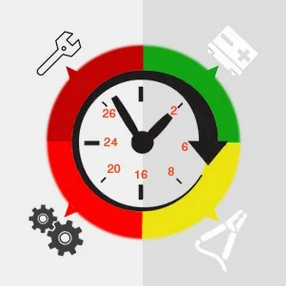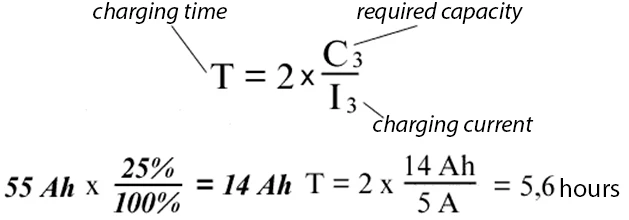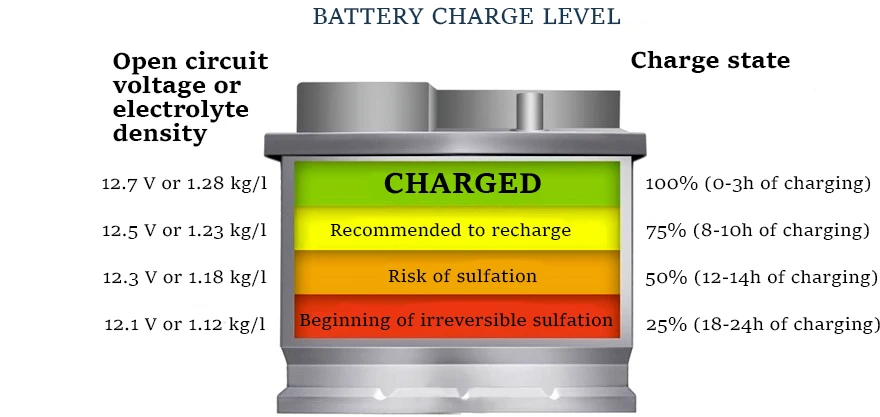Charging is required not only for a battery which has down fully (it is not desirable to allow that), but also for a battery in use. Only charging time will be different from each other. Often it is from 8 to 12 hours. Our online calculator will help to calculate how much time needs for charging a car battery, using a direct current.
When, how and what current is needed to charge
Generally, the state of battery charging is judged by the density of its electrolyte. The density of a fully charged battery should be 1.26-1.28 g / cm ³, voltage not less than 12.5 V. Everything will depend on what density of electrolyte has been initially installed in the new battery of your region of residence, it can be as 12.7V so as 12.9V. The lower the density, the more discharged it is. The decrease in density by 0.01 g / cm3 compared to the nominal means that the battery is discharged by about 6-8%. The degree of charging should be determined by the bank having the lowest density.
| Charging Degree (%) | Electrolyte Density (g/cm³) | Discharging Degree (%) | Battery voltage (V) | Charging time at 10% of capacity (hours) |
|---|---|---|---|---|
| 100 | 1,277 | 0 | 12,73 | There is no need |
| 90 | 1,258 | 10 | 12,62 | 2 |
| 80 | 1,238 | 20 | 12,50 | 4 |
| 70 | 1,217 | 30 | 12,37 | 6 |
| 60 | 1,195 | 40 | 12,24 | 8 |
| 50 | 1,172 | 50 | 12,10 | 10 |
| 40 | 1,148 | 60 | 11,96 | 13 |
| 30 | 1,124 | 70 | 11,81 | 16 |
| 20 | 1,098 | 80 | 11,66 | 20 |
| 10 | 1,073 | 90 | 11,51 | 24 |
| 0 | 1,06 | 100 | 11,4 | Sulfatation |
The lead-acid battery, which in summer is discharged by more than 50%, and in winter, even more than 25% must be removed and recharged. Also, an additional battery requires that battery, the density in the banks of which differs by more than 0.02 g/cm³.
The optimal charging current of the battery is considered to be current equal to 0.05 of its capacity (equalizing charge). So for a battery with a capacity of 55 Am / h, this value is 2.75 A, and for 60 Ah it is already 3 amperes. The purpose of this method is to ensure full recovery of the active masses in all battery plates.
Although they often use the so-called forced charge and take a different ratio — 10% of the capacity. That is, a standard car battery 55Ah is charged with a current of 2.75-5.5A, and for 60Ah batteries, the charging current is set in the range of 3A to 6A. But you need to know that the smaller the charging current, the deeper the charge, although it takes more time. Exactly the same situation with the supplied voltage — the more the faster, but it should not fall below 13.8 and exceed 14.5V). The charging voltage is raised to 16.0-16.5V only when charging a maintenance-free battery.
It is necessary to note that nowadays there are several methods for charging the battery:
- With direct current;
- At constant voltage;
- Combining in automatic mode (we will not consider this, since in this case the time calculator is not needed).

Stages of discharged car battery
Battery charging time at constant current
The formula for calculating the charging current is: I = Q * k, where Q is the battery capacity, and k is a certain ratio of the nominal (its ideal value is within 0.04… 0.06, and the optimal value is 0.1). Proceeding from such a recommendation, the calculation of the time that is needed for a fully loaded battery has the following form: T = Q / I. After substituting your values, you will see that a lot of time is obtained, but since, often, it does not require full charging, but only restoring the lost capacity, then this figure will be two or one and a half times less.
For an approximate estimate of the time required to charge a car battery with direct current, you must first determine the degree of discharge of the battery (in percent), then determine the lost capacity (in Ah), and then select the amount of charging current to calculate the full charge time. The formula for calculating how much time to recharge the car battery looks like that:

The multiplication of this ratio by 2 times, is needed because the efficiency of the process is 40-50%, the rest is spent on heating, as well as the associated electrochemical processes.
When within an hour at the battery terminals, when charging, the voltage stops increasing — the battery is charged at 100%.
The magnitude of the final voltage depends on: the magnitude of the charging current, temperature, internal resistance of the battery, the presence of impurities in the electrolyte and the composition of the alloy railings.
How to use the calculator
To find out how long you need to charge your battery there is no need to go into the details of all the processes and calculation formulas to use this calculator.
For online calculation, you must fill in all three fields:
- In the “Nominal Capacity” field enter the capacity of the rechargeable car battery.
- In the “Discharge level” field, you can enter both the percentage ratio calculated from the table and the voltage measured by a voltmeter.
- In the “Charging current” cell, you need to indicate with what kind of current you plan to charge the battery from the charger.
By pressing the “Calculate” button you will get the necessary time to fully charge a car battery.
FAQ
-
How long should I charge the battery to start the car?
To start the car and be able to drive in the summertime, it is enough to charge the battery for 30 minutes with a current of 10% of the battery capacity. This time is enough for its voltage to rise to 11.8 volts and the engine was able to start the starter without extra effort. In winter, you will need to put the battery on charge for at least 1 hour to raise its voltage to 12 volts. Further charging of the battery will come from the generator, when the car will be driven at speeds above 1500 rpm.
-
What does the charging speed of the battery depend on?
The charging speed depends on the amperage. The speed of the chemical reaction will accelerate as the charging current increases. The higher the current from the charger to the battery, the faster it will charge, but the hotter it gets. It is strictly forbidden to charge maintenance-free batteries with a high current.
-
How many amps should I use when charging a battery?
The nominal value of the charging current is 10% of its capacity. Therefore, you should use 4.5, 5.5, 6.0, or 7.0 amps when charging the battery. Depending on which battery you had to work with. And to calculate exactly how many amps you need to put on the charger, in your case, use the calculator by multiplying the capacity of the battery by 0.1.
-
How many hours to charge a 60 amp battery?
To understand how much to charge a 60ah battery, firstly you must determine the degree of sparsity of the battery. The average time to charge a dead battery is 10 to 12 hours. If a 60ah battery is put on charge at 6 amps when it has only 11.7V with an electrolyte density of 1.1 g/cm³, it will regain its full capacity in 14 hours. The final time depends on the level of discharge. The battery is considered fully charged when the voltmeter on its terminals will show 12.73V, and there will be active boiling of electrolyte.
-
How many amps should a charged battery indicate?
To check if the battery is charged, do not check how many amperes the multimeter shows, because a charged battery will not take any more amperes. On the terminals check the voltage, which should be at least 12.7V half an hour after charging and about 13.4V if checked immediately after disconnection. Therefore, how many amperes a charged battery should show is not a correct question.
If the charger has a built-in ammeter instead of indicator lights, how many amperes the charger (which charges with constant voltage) will show may be a question, but you will also see an arrow at zero (0,1 A) when fully charged. But if the charging was carried out with constant current, you should not control the current, it will be as it was originally set, — look at the voltage. A charged acid battery connected to the device will show 14.4V. Fully charged to 100% calcium battery will give 16.3V and the current will jump to 0.8A after it first dropped to 0.4, which will indicate the beginning of electrolysis.
